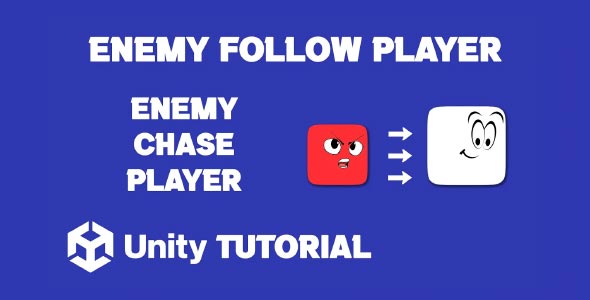Unity 2d enemy chase player mechanics are essential in designing engaging and dynamic gameplay for 2D games. Whether you’re building a side-scrolling platformer, a top-down shooter, or a puzzle-based adventure, the ability for enemies to react to the player’s presence and follow them intelligently can make a huge difference in the overall challenge and immersion.
In this guide, we’ll explore the design concepts and gameplay benefits of enemy chasing behavior. You’ll learn how to think about AI logic, collision interactions, pathfinding options, and balancing gameplay difficulty. The goal is to help you build smarter enemies that challenge the player without overwhelming or frustrating them.
Unity 2D Enemy Follow Player
When creating an AI that can Unity 2d enemy follow player, it’s important to first consider the context in which the enemy operates. For instance, in a side-scroller, following the player might mean running along a flat surface or navigating platforms. In a top-down game, the enemy might need to calculate directional movement in open space or through narrow paths.
It’s also essential to determine how the enemy detects the player. Will it use a visible range or a proximity trigger? Does it require a direct line of sight or can it sense the player through walls? These questions influence not only how the AI behaves but also how the player interacts with the game world. The goal is to give players the sense that they are being watched or pursued, which adds excitement and tension to gameplay.
Moreover, chasing behavior should reflect different types of enemy personalities or difficulty levels. For example, a slow but persistent enemy may follow the player over long distances, while a faster one might lose interest if the player escapes its immediate range. Designing these patterns helps add variety and keeps gameplay fresh.
Enemy Chase Player Unity
Designing an enemy chase player Unity system also requires balancing enemy speed and player abilities. If the enemy is too fast, the chase becomes unfair. If it’s too slow, there’s no tension. Matching the enemy’s speed to the player’s movement is essential for maintaining a satisfying challenge. You may also consider giving the enemy temporary speed boosts or special abilities to close gaps or create pressure during combat situations.
Additionally, you should think about how terrain affects enemy pursuit. Can the enemy jump across platforms, or does it avoid certain obstacles? Does it fall off ledges, or does it stop at edges? These details define how realistic and believable the enemy behavior feels. When players recognize and learn these patterns, it helps them strategize and improves overall gameplay flow.
It’s also worth considering how sound and animation reinforce the enemy’s pursuit. An alert sound when the enemy notices the player, or a shift in animation from idle to aggressive movement, communicates intent and helps players anticipate actions. This improves the sense of immersion and creates tension without the need for excessive visual cues.
Strategic Gameplay With Chasing Enemies Unity 2D
Adding a Unity 2d enemy chase player feature isn’t just about making your game harder. It’s about encouraging strategic decision-making. When players know enemies can follow them, they must think carefully about where to go, when to hide, or how to use the environment to their advantage.
Chasing mechanics often lead to more emergent gameplay. For example, players might lure enemies into traps, kite them into ambushes, or lead them away from key objectives. These moments feel dynamic and organic, even if the underlying system is relatively simple. The trick is to give players tools to outsmart the enemy rather than just outrun them.
This mechanic can also pair well with stealth or alert systems. Enemies might remain passive until they see or hear the player. Once alerted, they transition into chase mode. This builds tension, especially in levels where staying undetected is part of the challenge. It also allows for layered AI behavior, where enemies go from idle, to suspicious, to actively chasing.
Platformer Enemy Follow
The second time you implement Unity 2d enemy follow player logic, consider using it in combination with other mechanics such as patrolling or returning to a start position. This gives enemies more dynamic behaviors and allows you to design levels where players must anticipate patrol patterns and act accordingly.
You could also experiment with how enemies interact with one another. Do they work together to trap the player? Can they alert others? Collaborative enemy AI behavior elevates your gameplay complexity and keeps players engaged for longer periods.
Another benefit of intelligent chasing behavior is the potential for storytelling. Enemies that pursue players relentlessly or react with emotional cues can build narrative depth. Think of a boss enemy that stalks the player through several levels, adapting each time they encounter it. This kind of AI behavior turns standard enemies into memorable characters within the game.
Enemy Chase Player When In Range
With enemy chase player Unity systems, performance and optimization are also important. Too many active enemies chasing the player at once can hurt game performance, especially on mobile or low-spec devices. To mitigate this, you can use distance-based activation or pooling systems to manage how many enemies are active at a given time.
Another challenge to watch for is pathfinding accuracy. In more complex levels, you may need to guide enemies around obstacles or through narrow spaces. While you don’t need advanced pathfinding algorithms for every situation, using simple logic with obstacle avoidance or path nodes can make your enemies feel much smarter without significantly affecting performance.
It’s also helpful to allow player feedback to influence future improvements. If testers feel that the chase mechanics are too punishing or too easy, you can tweak detection radius, movement speed, or reaction time. Iteration is a key part of refining how enemies behave and how players respond to those behaviors.
Enhancing Game Feel and Player Experience
What makes the enemy chase player mechanic truly memorable is how it feels during play. Game feel includes sound design, animation transitions, environmental cues, and even camera effects. When an enemy begins to chase, shifting background music or a quick zoom can create a sudden spike in tension.
Consider providing rewards for players who successfully evade or defeat chasing enemies. Whether it’s bonus points, rare items, or unlocking new areas, these incentives make the chase more meaningful. It turns what could be a repetitive mechanic into something that’s tied to player progression and success.
You should also ensure that players understand the enemy’s behavior clearly. Use consistent animation states and recognizable sound effects so they can interpret what’s happening even when things get chaotic. This visual language helps reduce confusion and builds a more intuitive experience.
Conclusion
The Unity 2d enemy chase player mechanic is a versatile and impactful feature that can dramatically increase the intensity and strategy of 2D games. From visual feedback to sound design, from smart AI behavior to balanced movement speeds, each element contributes to making the chase feel real and exciting.
By using the Unity 2d enemy follow player design principle, you can build smarter, more reactive enemies that improve player engagement. Whether you’re creating stealth missions or intense combat scenes, the ability for enemies to pursue the player creates compelling gameplay loops.
The enemy chase player Unity mechanic is not just about pursuit. It’s about creating tension, encouraging smart decisions, and deepening the game’s challenge. With thoughtful design and balanced AI behavior, this feature can become a core pillar of your gameplay system—one that players will remember and enjoy.
Script: PlayerController.cs
using UnityEngine;
public class PlayerController : MonoBehaviour
{
public float moveSpeed = 5f;
public float jumpForce = 10f;
public Transform groundCheck;
public LayerMask groundLayer;
public float groundCheckRadius = 0.2f;
private Rigidbody2D rb;
private Vector2 moveDirection;
private bool isGrounded;
private void Start()
{
rb = GetComponent<Rigidbody2D>();
}
private void Update()
{
// Input handling
float moveX = Input.GetAxis("Horizontal");
moveDirection = new Vector2(moveX, 0).normalized;
// Check if player is on the ground
isGrounded = Physics2D.OverlapCircle(groundCheck.position, groundCheckRadius, groundLayer);
// Jump input
if (isGrounded && Input.GetButtonDown("Jump"))
{
rb.velocity = new Vector2(rb.velocity.x, jumpForce);
}
}
private void FixedUpdate()
{
// Apply movement
rb.velocity = new Vector2(moveDirection.x * moveSpeed, rb.velocity.y);
}
}Script: EnemyController.cs
using UnityEngine;
public class EnemyController : MonoBehaviour
{
public float moveSpeed = 3f;
public Transform player; // Reference to the player's transform
public float detectionRange = 10f; // Range within which the enemy will detect the player
private Transform enemyTransform;
private bool isFollowing = false; // Flag to indicate if the enemy should move
private void Start()
{
enemyTransform = transform;
}
private void Update()
{
// Check the distance between enemy and player
float distanceToPlayer = Vector2.Distance(enemyTransform.position, player.position);
// If player is within detection range, start moving towards the player
if (distanceToPlayer <= detectionRange)
{
isFollowing = true;
MoveTowardsPlayer();
}
else
{
isFollowing = false; // Stop moving if player is out of range
}
}
private void MoveTowardsPlayer()
{
if (isFollowing)
{
Vector2 direction = (player.position - enemyTransform.position).normalized;
enemyTransform.position = Vector2.MoveTowards(enemyTransform.position, player.position, moveSpeed * Time.deltaTime);
}
}
private void OnCollisionEnter2D(Collision2D collision)
{
// Check if the collision is with the player
if (collision.gameObject.CompareTag("Player"))
{
isFollowing = false; // Stop moving when colliding with the player
}
}
}Chasing the player adds urgency and life to your game’s enemies, but the behavior only works well when paired with proper detection. Be sure to implement or refine that logic using the Unity 2D Enemy Detect Player tutorial, so your enemies know exactly when to engage and when to wait.


